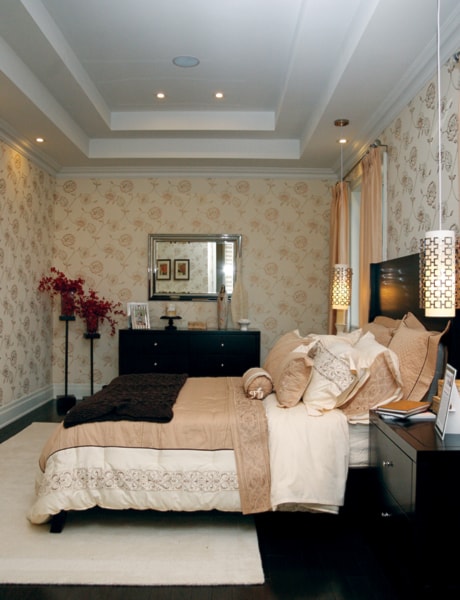Dear Debbie:
We have a coffered ceiling in our bedroom. The coffer and the main ceiling are painted white. I’d like to add moulding, but I don’t know where it would look best or what colour it should be in relation to the ceiling. I’d also like to paint the coffer a different shade than the ceiling. Please advise. Thank you. – Barbara
Dear Barbara:
Coffered ceilings have a rich architectural and decorative history with examples of breathtaking artistry and complexity seen throughout Roman and Renaissance times. The clean lines and simplicity of today’s coffered ceilings, such as the one in your bedroom, add to the feeling of height in the room as did their ornamented predecessors. The stepped detail also introduces a layer of architectural interest. How you choose to decorate the ceiling is a matter of taste; the possibilities are endless. In a room with no other trim or ornamentation, it is effective to simply paint the coffered ceiling white, or a very pale tint of blue. Or paint the upper tray and sides a slightly darker shade to set up a subtle contrast and diminish the feeling that there is a great white hole above you when you are in bed.
If you choose to add mouldings at the top of the wall, select a cornice with enough thickness to visually hold up the weight of the ceiling, as the ceiling will appear to be resting on the cornice. For a big impact, there are wonderful architectural wallpapers or murals available that you can apply inside the tray. In a bedroom, you don’t want the ceiling to feel top heavy, so look for a design that draws the eye to the centre of the ceiling.
Dear Debbie:
The master bedroom in our 1930s home is 14’x18’ with a 5’x8’ alcove. The ceiling curves down to about 4 feet from the floor on one side of the room, and curves down on two sides to meet the alcove. How do I paint this room? I would like to use shades of purple but don’t know where to start and stop on the curves. I enjoy reading your columns. – Joyce
Dear Joyce:
These rooms have lots of character but can be tricky to decorate as there doesn’t appear to be a natural stop and start point for painting. Why not paint the ceiling and walls in the bedroom lilac, and then apply a darker version of the same colour (purple) to the walls in the alcove. Wallpaper is another option for the alcove and would highlight the area beautifully. Look for today’s oversized, simplistic florals, and because the space is small it will be affordable.
Dear Debbie:
We just moved into a condo that has stucco ceilings everywhere but the kitchen and bathroom. We want to redecorate and are not sure how to paint the stucco. Can I paint the bedroom ceiling a colour (I’m thinking about mustard yellow) or should the stucco all be white? Thanks. – Tomas
Dear Tomas:
Painting stucco can be a bit problematic because of the uneven texture and the fragile nature of the plaster. You will find that even wiping across it or brushing it will cause bits to fall off. Always wear protective eye glasses, move the furniture out and cover up the floor. Stucco is also very porous, so begin by applying a paint primer with a soft brush or roller, using gentle strokes, and let the primer dry overnight.
You can paint stucco any colour you choose. Rich dark yellow will give the room old world charm if the walls are also covered in a dark hue. Otherwise it is best not to draw the eye to the stucco, so keep it white.
Debbie Travis’ House to Home column is produced by Debbie Travis and Barbara Dingle. Please email your questions to house2home@debbietravis.com.
